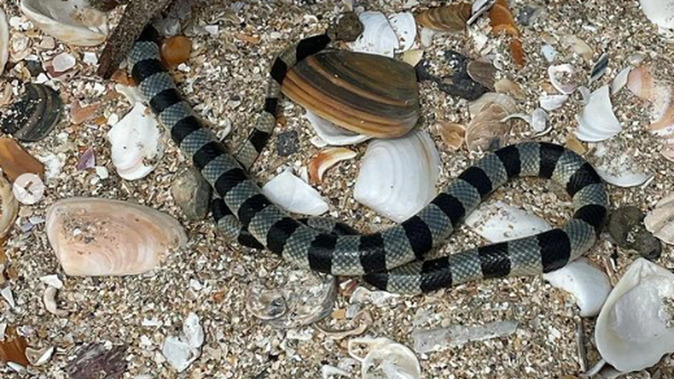
An Auckland woman panicked when she found a live and highly venomous snake on Takapuna Beach, reported it to the Department of Conservation, and was told to set it free.
Armed with only a dog poo bag and a stick, Afrika McNall trapped the snake, which she said appeared to be a yellow-lipped banded sea krait, only to be warned by the Department of Conservation (DoC) she could face animal cruelty charges.
It is the second sighting of a snake in New Zealand in little over a month since the same species was spotted swimming in Auckland’s Viaduct Habour.
And a research scientist at the Australian Institute of Marine Science who specialises in sea snake ecology and distribution, Vinay Udyawer, told the Herald sightings of these snakes could increase as the climate warms, and it “may not be far off” until they could establish themselves here.
/cloudfront-ap-southeast-2.images.arcpublishing.com/nzme/V5V24IHP2DWJ73H2T762NYDLGI.jpg) During off leash hours, dogs can have all the fun on Takapuna Beach. Photo / Supplied
During off leash hours, dogs can have all the fun on Takapuna Beach. Photo / Supplied
“It was absolutely insane,” McNall told the Herald. She was walking along the beach about midday Tuesday with friends and some kids when one girl screamed out “snake!”
Initially thinking the girl was overreacting, “oh my gosh, dramatic”, she said of the girl’s alarm, she was stunned to see a snake crawling around on the sand.
Given New Zealand has no snakes, she acted quickly to trap the snake and report it to DoC so it couldn’t breed and establish itself here.
The snake is still alive and being kept at Auckland Zoo. DoC confirmed to the Herald it was not intending to prosecute McNall on any animal cruelty charges.
It is the latest in a series of appearances of venomous snakes in our waters, coming after a rash of sightings of the yellow-bellied sea snake last year.
- 'Do not swim': Warnings at most Auckland beaches due to high levels of faecal bacteria
- Person dies after emergency service call-out at New Brighton beach
- Shark sightings lead to grisly discovery
/cloudfront-ap-southeast-2.images.arcpublishing.com/nzme/X6RC4QS4PVEJTCGRPY2SU2VQNM.PNG)
DoC’s operations manager Auckland mainland, Rebecca Rush, told the Herald that banded sea kraits were “occasional visitors” to Aoteroa, and were considered a native species under the Wildlife Act 1953 because they arrive here naturally on ocean currents.
This meant it was illegal to kill or harass a sea snake or possess one or any part of one without a permit. Rush said DoC told McNall not to touch or handle the snake for its own and her safety, as it was “highly venomous”.
McNall confirmed she was told this, but “couldn’t believe” DoC would tell her to let it go. She said DoC told her the snake was “10 times as venomous as a rattlesnake”.
“The whole group I was with were looking at me [while I was on the phone to DoC] thinking, ‘what the heck?’, I can’t believe we’re letting this really venomous snake go. I didn’t think it was morally right.”
She said DoC eventually told her a zoologist would come to the beach to take the snake, 40 minutes after she initially called. However, she was concerned she could be prosecuted if caught with the snake inside the bag and decided to leave the snake inside on the beach.
/cloudfront-ap-southeast-2.images.arcpublishing.com/nzme/AEIVBMLRAREB5FQK5RUJKS3QQY.jpg) Banded sea kraits can be found in the water - and on land. Photo / Supplied
Banded sea kraits can be found in the water - and on land. Photo / Supplied
The animal, which breeds in the tropical waters of the northern Tasman Sea, has been seen as far south as the Manawatū coastline, where a man was prosecuted last year for taking one from a beach.
The Australian Institute of Marine Science’s Udyawer said the number and likelihood of sightings of snakes were likely to increase as oceans warmed and currents changed as effects of climate change.
“The chances [of these snakes establishing a population in New Zealand] might increase as the environment becomes more tropical. With things accelerating as they are, it may not be as far off as you’d expect,” he said.
“In the short to medium term, it’s unlikely they can establish a breeding population in New Zealand because resources they rely on aren’t [here]. They rely on tropical habitats.”
Udyawer said some tropical snake species were now being seen in Sydney and Hobart, and it was “on trend” for New Zealand to see these too.
Take your Radio, Podcasts and Music with you









